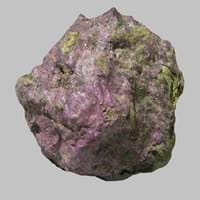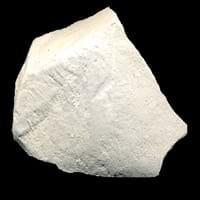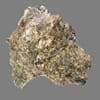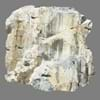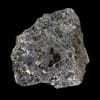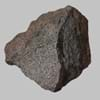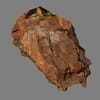Definition
Wehrlite is an ultramafic and ultrabasic rock that is a mixture of olivine and clinopyroxene. It is a subdivision of the peridotites
Chalk is a soft, white, powdery limestone consisting mainly of fossil shells of foraminifers
Discoverer
Alois Wehrle
Unknown
Etymology
From the name of a professor, Alois Wehrle
From old English cealc chalk, lime, plaster; pebble, from Greek khalix small pebble, in English transferred to the opaque, white, soft limestone
Class
Igneous Rocks
Sedimentary Rocks
Sub-Class
Durable Rock, Medium Hardness Rock
Durable Rock, Soft Rock
Group
Plutonic
Not Applicable
Other Categories
Coarse Grained Rock, Opaque Rock
Fine Grained Rock, Opaque Rock
Texture
Banded
Clastic or Non-Clastic
Color
Dark Greenish - Grey, Green
Grey, White, Yellow
Durability
Durable
Durable
Appearance
Rough and Banded
Soft
Interior Uses
Decorative Aggregates, Interior Decoration
Decorative Aggregates, Homes, Interior Decoration
Exterior Uses
As Building Stone, As Facing Stone, Garden Decoration, Paving Stone
As Building Stone, As Facing Stone, Paving Stone, Garden Decoration
Other Architectural Uses
Curbing
Powder
Construction Industry
As Dimension Stone, Cobblestones
As Dimension Stone, Cement Manufacture, Construction Aggregate, for Road Aggregate, Making natural cement, raw material for manufacture of quicklime and slaked lime, Source of calcium
Medical Industry
NA
Not Yet Used
Antiquity Uses
Artifacts, Monuments, Sculpture, Small Figurines
Artifacts, Monuments, Sculpture, Small Figurines
Commercial Uses
Cemetery Markers, Creating Artwork, Gemstone, Jewelry
Alumina Refineries, Creating Artwork, Drawing on blackboards, Gymnasts, athletes and mountain climbers use for grip, In aquifers, Paper Industry, Production of Lime, Raw material for manufacture of quicklime, slaked lime, Soil Conditioner, Whiting, Whiting material in toothpaste, paint and paper
Types
Not Available
Not Available
Features
Constitutes upper part of the Earth's mantle, Generally rough to touch, Is one of the oldest rock
Clasts are smooth to touch, Is one of the oldest rock, Smooth to touch, Very fine grained rock
Archaeological Significance
Famous Monuments
Data Not Available
Data Not Available
Famous Sculptures
Data Not Available
Data Not Available
Formation
Wehrlite is a fine-grained, hard rock which is a type of metasomatite, essentially altered basalt. It forms with or without crystallization, either below the surface as intrusive rocks or on the surface as extrusive rocks.
Chalk is formed from lime mud, which accumulates on the sea floor which is then transformed into rock by geological processes.
Mineral Content
Pyroxene
Calcite, Clay, Clay Minerals, Quartz, Sand
Compound Content
Aluminium Oxide, CaO, Carbon Dioxide, Iron(III) Oxide, FeO, Potassium Oxide, MgO, Sodium Oxide, Phosphorus Pentoxide, Silicon Dioxide, Titanium Dioxide
Ca, NaCl, CaO
Types of Metamorphism
Burial Metamorphism, Cataclastic Metamorphism, Contact Metamorphism, Impact Metamorphism, Regional Metamorphism
Not Applicable
Types of Weathering
Biological Weathering, Chemical Weathering, Mechanical Weathering
Biological Weathering, Chemical Weathering
Types of Erosion
Chemical Erosion, Coastal Erosion, Water Erosion
Chemical Erosion, Coastal Erosion, Water Erosion
Grain Size
Coarse Grained
Very fine-grained
Fracture
Irregular
Not Available
Porosity
Less Porous
Highly Porous
Cleavage
Perfect
Non-Existent
Specific Gravity
8.4
2.3-2.4
Transparency
Opaque
Opaque
Density
2.6-3.7 g/cm3
2.49-2.50 g/cm3
Resistance
Heat Resistant, Impact Resistant, Pressure Resistant
Heat Resistant
Deposits in Eastern Continents
Asia
China, India, Indonesia, Kazakhstan, Russia, South Korea, Thailand, Turkey
Brunei, India, Indonesia, Malaysia, Singapore, Thailand, Vietnam
Africa
Morocco, South Africa
Cameroon, Chad, Ghana, Kenya, Malawi, Sudan, Tanzania, Togo, Zambia, Zimbabwe
Europe
Finland, France, Georgia, Germany, Great Britain, Italy, Kazakhstan, Netherlands, Norway, Spain, Switzerland, Venezuela
England, France, Germany, Spain, United Kingdom
Others
Not Yet Found
Not Yet Found
Deposits in Western Continents
North America
Canada, USA
Canada, USA
South America
Brazil
Colombia
Deposits in Oceania Continent
Australia
New Zealand, Western Australia
Adelaide, New Zealand, Queensland, Tonga, Victoria, Yorke Peninsula
All about Wehrlite and Chalk Properties
Know all about Wehrlite and Chalk properties here. All properties of rocks are important as they define the type of rock and its application. Wehrlite belongs to Igneous Rocks while Chalk belongs to Sedimentary Rocks.Texture of Wehrlite is Banded whereas that of Chalk is Clastic or Non-Clastic. Wehrlite appears Rough and Banded and Chalk appears Soft. The luster of Wehrlite is metallic while that of Chalk is dull. Wehrlite is available in dark greenish - grey, green colors whereas Chalk is available in grey, white, yellow colors. The commercial uses of Wehrlite are cemetery markers, creating artwork, gemstone, jewelry and that of Chalk are alumina refineries, creating artwork, drawing on blackboards, gymnasts, athletes and mountain climbers use for grip, in aquifers, paper industry, production of lime, raw material for manufacture of quicklime, slaked lime, soil conditioner, whiting, whiting material in toothpaste, paint and paper.
